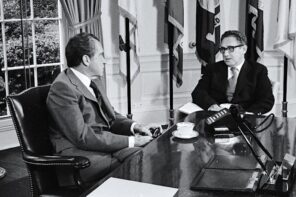Editor’s Note: While it may be buried in the headlines, genocide (and its aftermath) continues across the globe:
*As a senator, Barack Obama noted that “an ongoing genocide” is taking place in Sudan. The president’s envoy, however, recently extended a friendly, incentives-first hand to Sudan’s president, an indicted war criminal.
*In Finland on September 1 the trial of Francois Bazaramba began; the former Baptist Pastor was charged with organizing mass killings during the Rwandan genocide of 1994. The trial is taking place in Finland under what’s known as the “Universality Jurisdiction,” which states that any nation may prosecute if “the crime committed is considered a crime against all.”
*The trial of Kaing Guek Eav or “Duch,” the head of the Khmer Rouge’s Tuol Sleng prison, continues this week. According to Reuters: “He has admitted involvement in the deaths of 14,000 people at the Tuol Sleng prison, but insists he was only following orders.”
Seated on a bus in downtown Rome recently, I overheard snippets of conversation between a Nigerian priest who had been there for two years studying theology and a Polish woman who had recently arrived and was looking for work. She asked him how he liked living in Rome; he balked. It sounded as if the Eternal City were, to his eyes, undeniably beautiful, if a bit cold and its people puzzling. There was a certain moral seriousness missing, somehow. But then, he’d been in the city for some time; he’d had time to dig a bit more deeply into the nuances of the place. She had just arrived.
He gracefully shifted topics by asking her where she was from; she mentioned a small town he did not know. “It’s not far from Auschwitz,” she said, “where Hitler killed the Jews.”
Adolf Hitler: The man who killed the Jews. It’s a common enough way of putting things, a generation after the fact. Or at least it used to be until 1996, when a major cultural controversy was initiated by Daniel Jonah Goldhagen’s book, Hitler’s Willing Executioners. The whole point of the book was to remind us that this is a false way of describing what happened during the war. Hitler had an army of willing executioners, and they were not even all Party members. It took far more than an SS to wage such a war. So who killed the Jews? “Grandma and grandpa” is another, far more unsettling, way to answer the question, Goldhagen suggested.
It can sometimes appear as if it were the desire of an entire generation not to be implicated in Nazi atrocities that led to the creation of these subtle discourses of distance, a way to detach ourselves now from the horror of then.
This story—the story of the complexity of assessing culpability in the face of mass movements and mass crimes—was one that had already been told in 1964 by Hannah Arendt in her controversial book, Eichmann in Jerusalem. What shocked its original readership was not so much what she referred to as “the banality of evil” as it was the fact of Jewish collaboration, under duress, in the transportation and execution of their fellows. Who killed the Jews? Grandma’s and grandpa’s entire generation—victims and executioners alike. This is not a banal story at all; it is unspeakable. And it is not a story best told in court, Arendt concluded.
The United Nations created a new word—genocide—to try to capture what was clearly perceived to be a new kind of horror that had been unleashed on the world. It was not simply that the body counts in the course of two world wars had grown unimaginable, and it was not the fact of indiscriminate killing technology either. It was more the fact that quantitative changes can become qualitative. The Shoah represented a new and unprecedented moral situation, a horror of which the human race was now deemed to be capable, forever after. And we have been steadily, tragically reminded of this fact in the sixty years since the end of the Second World War.
One of the many challenges in confronting the history of genocide is precisely this difficulty of knowing how to assess moral responsibility. Who is responsible for the Shoah, if it is not Hitler alone and it is not the entire nation of Germany? Taking responsibility (or even assessing it) is enormously difficult to accomplish in the mass.
But taking individual responsibility has been trivialized in our time. Politicians have turned it into a farcical art form and parlor game. “The buck stops here,” they say. But only in so far as there are no actual consequences for the taking of such responsibility. In those cases, we prefer to “pass the buck.” Susan Wise Bauer’s The Art of the Public Grovel (Princeton, 2008) paints a damning portrait of what have become virtually the conventions of a new genre: the public apology for a personal scandal. Jimmy Swaggart, Jim Bakker, Bill Clinton, and more recently Mark Sanford and John Ensign; the trick is that one must admit to wrongdoing, and express sincere regret, yet one may refer to the actual deed only in the vaguest and most general terms. Come any closer to the mention of an actual transgression, Bauer suggests, and the public may not be so forgiving.
When we move from the realm of private sex scandal to mass killing, however, in the face of attempted genocides from Cambodia to Rwanda to Darfur, it has been difficult to know how to imagine forgiveness at all. Is it possible to forgive the Shoah? Who should be forgiven? And who is responsible? Or are these the wrong questions to pose, a generation after the fact? Is it now rather a matter of being reconciled to a history we all presumably wish had been different, the proverbial “past that will not pass”? Does the moral task lie in dealing with this past, or looking ahead to a hopefully less genocidal future?
One of the striking things about the trial of Kaing Guek Eav (the alleged chief interrogator at the Tuol Sleng jail) are its morally-muted tones. The man is 66 years old, after all, and he has expressed what appears to be a heartfelt apology to the individuals he tortured and the families he left bereft. He is accused of presiding over some 12,380 deaths at the prison, and yet this horrific figure pales in comparison to the estimated 1.6 million souls believed to have been lost under the regime of social engineering promoted by the Khmer Rouge. One fifth of the entire Cambodian population was lost to the so-called Killing Fields, which means that the country today is demographically very young, and there are not many people left to remember. Thus the trial, much like Adolf Eichmann’s in Jerusalem, has a certain surreality about it.
This raises an interesting and timely question: do we perhaps turn to the wrong institutions when we go to courts of law to attempt to enact forgiveness or reconciliation? Courts are neither forgiving nor reconciling institutions, after all; they are punitive ones. It is debatable what the Nuremberg Trials achieved, apart from naming a collective shock and horror in the immediate aftermath of the war. As Richard Rubenstein noted in his provocative essay After Auschwitz (1966), it is even debatable whether they were legal, given that new crimes had to be created after the fact, under which some Nazi defendants could be tried, and then executed.
The record of “Truth and Reconciliation Commissions” has not necessarily been a happier one—witness the renewed ethno-racial strife in South Africa, a strife brilliantly if brutally anticipated by Nobel Laureate J.M. Coetzee in his novel, Disgrace (1999).
So who is responsible, when an entire society is implicated in a crime? Where to turn for reconciliation now, a generation later? I wonder if we might better turn to artists to imagine new and different ways forward. The ancient Greeks portrayed complicated notions of moral responsibility and enacted reconciliation on the tragic stage. Forgiveness and reconciliation were staged and performed; these were understood to be the collective, ritual work of the tragic form itself.
Writers in South Africa, and even more so in Northern Ireland, have returned to the Greek well as they have tried to imagine a way forward in their own societies; one thinks of dramatic adaptations of Sophocles by Athol Fugard (The Island) and Seamus Heaney (The Cure at Troy) in this context.
What might it be to look, and then to listen, to what Cambodian artists, rather than their politicians and lawyers, are saying about the current trials; and the virtually speechless history they have called back to consciousness, crimes to which we all can give, at best, an imperfect voice.
The real dilemma is that we are attempting to speak for the dead, and we are justifiably uncertain of our rights (and capacities) to do so. Perhaps this is where poetry can help. The Odyssey (and what was the twentieth century, if not a moral odyssey?) was one of the first poems to imagine how we gain voices of the dead a hearing in Tragic sacrifice. The kind that lays a claim on all of us.
In 1954, the French writer Marguerite Yourcenar, herself no stranger to calamity, put the dilemma thus:
The sorcerer who pricks his thumb before he evokes the shades knows well that they will heed his call only because they can lap his blood. He knows, too, or he ought to know, that the voices who speak to him are wiser and more worthy of attention than are his own clamorous outcries.




